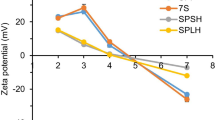Abstract
SCP-20, an SCP-carbon which is a treated SCP-20 with active carbon, and extracts of St John's wort (St-wort) were tested to compare their anti-stress effects. When the SCP-20, SCP-carbon and St-wort were ingested by the rats for 8 days prior to being subjected to a 48 h stress period, they showed anti-stress effects on their changes of weight for the adrenal glands, spleen, thymus and thyroid in comparison with the stressed control. The levels of epinephrine and norepinephrine in plasma were increased by immobilized stress. St-wort, SCP-20, and SCP-carbon lowered the elevated levels of epinephrine and norepinephrine to near control levels. Emulsifying and foaming properties of the SCP-20 and SCP-carbon were measured in the range pH 3–8. The emulsifying activities of yeast hydrolysates increased to a high level near neutral pH, but decreased in acidic conditions. The emulsifying activity in SCP-carbon was higher in the acidic pHs than that in SCP-20. The patterns of the emulsion stabilities for SCP-20 and SCP-carbon were similar to those of the emulsifying activities. SCP-20 and SCP-carbon showed poor foaming capacity from pH 4.0 to 7.0. In particular, SCP-carbon showed lower foaming capacity and foam stability than SCP-20.


Similar content being viewed by others
References
Schmidl MK, Taylor SL, Nordlee JA (1994) Food Technol 48:77–80
Meisel H (1997) Biopoly 43:119–128
Grenby TH (1991) Trends Food Sci Technol 2:2–6
Markus CR, Olivier B, De Haan EEHF (2002) Am J Clin Nutr 75:1051–1056
Lepage O, Tottmar O, Winberg S (2002) J Exp Biol 205:3679–3687
Yu KW, Kim JM,Oh SH, Suh HJ (2002) Food Res Int 35:879–884
Brekhman II, Dardymov IV (1969) Lloydia 32:46–51
Smith CCT, Curtis LD, Delamonthe AP, Prichard BNC, Betteridge DJ (1985) Clin Sci 69:1-6
Pearce KN, Kinsella JE (1978) J Agric Food Chem 26:716–723
Sathe SK, Salunkhe DK (1981) J Food Sci 46:71–74, 81
Khansari DN, Murgo AJ, Faith RE (1990) Immunol Today 11:170–175
Linde K, Ramirez G, Mulrow CD, Pauls A, Weidenhammer W, Melchart D (1996) Br Med J 313:253–258
Bateman A, Singh A, Kral T (1989) Endocr Rev 10:92–111
Lodish H (1995) Molecular cell biology. Scientific American Books. Freeman, New York, pp 124–135
Rhoades R, Pflanzer R (1996) Human physiology. Saunders College Publishing, San Francisco, pp 87–102
Ochiai K, Kamata Y, Shibsaki K (1982) Agric Biol Chem 46:91–96
Shih FF (1987) J Food Sci 52:1529–1531
Casella MLA, Whitaker JR (1990) J Food Biochem 14:453–475
Author information
Authors and Affiliations
Corresponding author
Rights and permissions
About this article
Cite this article
Kim, J.M., Lee, S.W., Kim, K.M. et al. Anti-stress effect and functionality of yeast hydrolysate SCP-20. Eur Food Res Technol 217, 168–172 (2003). https://doi.org/10.1007/s00217-003-0723-2
Received:
Revised:
Published:
Issue Date:
DOI: https://doi.org/10.1007/s00217-003-0723-2




